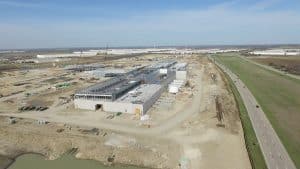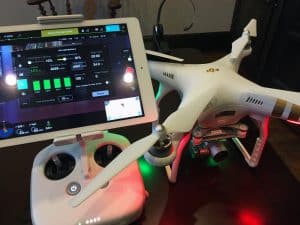Most orders for IN STOCK items placed by 12PM CST M-F ship SAME DAY. Orders for custom items and prints may take additional time to process.
I would also point out that Cessna airplanes and hot air balloons rigged with Go-Pros are also flying over your data center almost every day. In addition to just regular citizens flying recreationally, taking photos and video for their families, there are also professional photography companies taking high resolution photos for the likes of Bing’s “Bird’s Eye View” in its mapping product. And don’t even get me started about these new high resolution LEO photography satellites that our government and private agencies are flying.
So if all of that is happening already why should we protect our data centers from drones? And for that matter is it eve possible for data centers to be protected from drones?
I recently flew my own Phantom 3 Professional drone over Facebook’s Fort Worth Data Center. The aerial footage from the Phantom turned out great. The sun was in the right position and there was little wind. I couldn’t have been happier with how it turned out. So I whipped together a little video for The Geek Pub thinking some of my audience might enjoy it and posted it to The Geek Pub channel on YouTube. You can see a freeze frame from that video below.
To my surprise, a few days later I got an inbox message on Facebook from Facebook asking me to come onsite to take a tour of the facility by one of their employees. Long story short, I ended up on the phone with this guy a few days later and the topic eventually turned to drones, and how it related to data center security.
Now before we go any further, Facebook was very cool headed about this situation. They were nothing but over the top friendly. That’s not to say that they were 100% happy about a drone flying over their facility taking video. They did have some concerns with security and proprietary information possibly getting into the hands of their competitors.
Let’s start first with where this stands legally, based on FAA regulations and state and local laws. Since I am not into breaking the law, or even being into grey areas of the law, the first thing I did when I bought my drone was register it with the FAA and read the Texas laws on flying drones. The law here in Texas is pretty simple:
That’s pretty much it in Texas. You own the land that you live on or do business on, but you do not own the airspace above it. Imagine if a fleet of hot air balloons flew over your home at 200 ft. It wouldn’t even cross your mind to call the police. You can be certain there are GoPro cameras attached to the balloons, and you can be sure at least some of the pilots are taking pictures with zoom lenses attached to DSLR cameras!
So why is it that the thought of a drone scares us so much? Two reasons! First, blame the media. They have spent the last year vilifying drones. It makes for a great news story. And they don’t care about anything else. Second, because they are getting extremely popular and affordable. Almost anyone can own and operate a drone. Not just anyone can fly a Cessna airplane or hot air balloon over your home (or business). This means the flights were far and few between and generally flying over your home was a coincidence, or just random luck of the draw. With drones, it is likely the structure, or home it flew over was targeted as a point of interest. That’s not always true, because they may be simply flying over your home or data center to get to another point of interest, but its much more likely.
That being said, many in the legal profession are advising drone operators to maintain an altitude of at least 200 feet when flying over property they don’t own. There is going to be a big difference if you wind up in court and you were flying your drone up to someone’s bedroom window, or flying 200 foot over the top of their house. Also, please keep in mind that I am only working with Texas law in this article, and I am not a lawyer. You should consult one in your state for legal advice.

Let’s start by determining what our risks are. It’s not as simple as ignoring the problem. I also doubt the laws are going to change much to protect your data center either. And you might be surprised when you hear me say “I don’t want stricter laws on drones.” What? That’s right. Benjamin Franklin said “Those who would give up essential Liberty, to purchase a little temporary Safety, deserve neither Liberty nor Safety.” and he is absolutely right. It’s on us as operators of data centers to make sure that they are secure and that confidential things stay confidential. We don’t leave the IP address of our data center’s management console(s) on the home page of our website do we?
Step 1 is that we need to make sure that there is no information on the outside of our data center that could be used by a competitor or an attacker:
Step 2 is to protect what enters and exits the building:
Step 3 is to protect information from competitors:
Step 4 is to assume your data center has a drone flying over it 100 times a day:
Step 5 is to assume at some point a hacker will land a drone on top of your data center, or use it to drop hacking equipment on the roof or grounds of the facility:
The bottom line is that unless you are the government with sweeping authority you won’t be able to stop the drone flyovers of your data center. You should instead not even try. You should assume it is happening every day, and make sure that your facility and grounds are hardened against such threats. Disruptive technologies come along quite often. Drones are just the latest. As operators of data centers we should be forever vigilant in the protections we put in place to maintain them, and keep them secure. We should assume the worst will happen, and always be prepared for it.

If you like our content maybe consider upgrading to Premium. You’ll get access to
4 Responses
I think you’re right. There’s no reason to expect that criminals are going to follow the law. There’s also zero reason to expect the government will do the right thing. They’ll make some knee jerk reaction law that helps no one. Great read!
Maggie – you’re right. The last thing we need is a government response to drones. We need business to take reasonable precautions. You wouldn’t leave the front doors to your jewelry store unlocked at night would you? 🙂
I don’t want to come across as an asshat, I really don’t but if Facebook is dumb enough to have not already protected themselves against drone threats then I don’t want my data on their servers. I suspect they are smarter than that.
Yes. Such great insight! And I agree, the government and the FAA need to leave the drones be. The hot air balloon analogy is perfect!